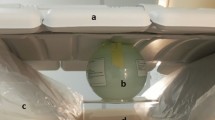Abstract
Magnetic resonance (MR) imaging is commonly used in the clinical setting to non-invasively monitor the body. There exists a large variability in MR imaging due to differences in scanner hardware, software, and protocol design. Ideally, a processing algorithm should perform robustly to this variability, but that is not always the case in reality. This introduces a need for image harmonization to overcome issues of domain shift when performing downstream analysis such as segmentation. Most image harmonization models focus on acquisition parameters such as inversion time or repetition time, but they ignore an important aspect in MR imaging—resolution. In this paper, we evaluate the impact of image resolution on harmonization using a pretrained harmonization algorithm. We simulate 2D acquisitions of various slice thicknesses and gaps from 3D acquired, 1 mm\(^3\) isotropic MR images and demonstrate how the performance of a state-of-the-art image harmonization algorithm varies as resolution changes. We discuss the most ideal scenarios for image resolution including acquisition orientation when 3D imaging is not available, which is common for many clinical scanners. Our results show that harmonization on low-resolution images does not account for acquisition resolution and orientation variations. Super-resolution can be used to alleviate resolution variations but it is not always used. Our methodology can generalize to help evaluate the impact of image acquisition resolution for multiple tasks. Determining the limits of a pretrained algorithm is important when considering preprocessing steps and trust in the results.
Access this chapter
Tax calculation will be finalised at checkout
Purchases are for personal use only
Similar content being viewed by others
References
Avants, B.B., et al.: Advanced normalization tools (ANTS). Insight J 2(365), 1–35 (2009)
Biberacher, V., et al.: Intra-and interscanner variability of magnetic resonance imaging based volumetry in multiple sclerosis. NeuroImage 142, 188–197 (2016)
Carass, A., et al.: Image harmonization improves consistency of intra-rater delineations of MS lesions in heterogeneous MRI. NeuroImage: Reports 4(1), 100195 (2024)
Clark, K.A., et al.: Intersite brain mri volumetric biases persist even in a harmonized multisubject study of multiple sclerosis. Journal of Neuroimaging 33(6), 941–952 (2023)
Dewey, B.E., et al.: DeepHarmony: a deep learning approach to contrast harmonization across scanner changes. Magnetic Resonance Imaging 64, 160–170 (2019)
Dewey, B.E., et al.: Improving the utilization of standardized MRIs in multiple sclerosis care: a pragmatic trial perspective. In: The Consortium of Multiple Sclerosis Centers (2021)
Hays, S.P., et al.: Quantifying contrast differences among magnetic resonance images used in clinical studies. In: The Consortium of Multiple Sclerosis Centers (2023)
He, Y., et al.: Self Domain Adapted Network. In: International Conference on Medical Image Computing and Computer-Assisted Intervention. pp. 437–446 (2020)
Ikonomidou, V.N., Sergiadis, G.D.: Improved Shinnar–Le Roux algorithm. Journal of Magnetic Resonance 143(1), 30–34 (2000)
Martin, J., et al.: SigPy. RF: comprehensive open-source RF pulse design tools for reproducible research. In: Proceedings of the International Society for Magnetic Resonance in Medicine. ISMRM Annual Meeting. vol. 1045 (2020)
Pauly, J., et al.: Parameter relations for the Shinnar-Le Roux selective excitation pulse design algorithm (NMR imaging). IEEE Trans. Med. Imag. 10(1), 53–65 (1991)
Prince, J.L., Links, J.M.: Medical imaging signals and systems. Pearson Prentice Hall Upper Saddle River (2006)
Remedios, S.W., et al.: Self-supervised super-resolution for anisotropic MR images with and without slice gap. In: Workshop on Simulation and Synthesis in Medical Imaging (SASHIMI) held in conjunction with the 26\(^{\rm th}\) International Conference on Medical Image Computing and Computer Assisted Intervention (MICCAI 2023). Lecture Notes in Computer Science, vol. 14288, pp. 118–128 (2023)
Remedios, S.W., et al.: Pushing the limits of zero-shot self-supervised super-resolution of anisotropic mr images. In: Proceedings of SPIE Medical Imaging (SPIE-MI 2024), San Diego, CA, February 18 – 22, 2024. vol. 12926, pp. 1292606–1292606–7. SPIE (2024)
Tustison, N.J., et al.: N4ITK: improved N3 bias correction. IEEE Transactions on Medical Imaging 29(6), 1310–1320 (2010)
Wattjes, M.P., et al.: 2021 MAGNIMS–CMSC–NAIMS consensus recommendations on the use of MRI in patients with multiple sclerosis. Lancet Neurology 20(8), 653–670 (2021)
Wu, Z., et al.: ES-SR3: Early-stopping denoising diffusion probabilistic model for MR super-resolution. In: Machine Learning in Medical Imaging (MLMI 2024). Lecture Notes in Computer Science (2024)
Zuo, L., et al.: An overview of disentangled representation learning for MR image harmonization. In: Zhou, S.K., Greenspan, H., Shen, D. (eds.) Deep Learning for Medical Image Analysis (Second Edition), chap. 5, pp. 266–290. elsevier (2024)
Zuo, L., et al.: Information-based disentangled representation learning for unsupervised MR harmonization. In: International Conference on Information Processing in Medical Imaging. pp. 346–359. Springer (2021)
Zuo, L., et al.: Unsupervised MR harmonization by learning disentangled representations using information bottleneck theory. NeuroImage 243, 118569 (2021)
Zuo, L., et al.: Disentangling a single MR modality. In: Data Augmentation, Labelling, and Imperfections. pp. 54–63. Springer Nature Switzerland (2022)
Zuo, L., et al.: HACA3: A unified approach for multi-site MR image harmonization. Computerized Medical Imaging and Graphics 109(102285) (2023)
Acknowledgments
This material is partially supported by the Johns Hopkins University Percy Pierre Fellowship (Hays) and the National Science Foundation Graduate Research Fellowship under Grant No. DGE-2139757 (Hays) and Grant No. DGE-1746891 (Remedios). Development is partially supported by FG-2008-36966 (Dewey), CDMRP W81XWH2010912 (Prince), NIH R01 CA253923 (Landman), NIH R01 CA275015 (Landman), the National MS Society grant RG-1507-05243 (Pham) and Patient-Centered Outcomes Research Institute (PCORI) grant MS-1610-37115 (Newsome and Mowry). The statements in this publication are solely the responsibility of the authors and do not necessarily represent the views of the Patient-Centered Outcomes Research Institute (PCORI), its Board of Governors or Methodology Committee.
Author information
Authors and Affiliations
Corresponding author
Editor information
Editors and Affiliations
Rights and permissions
Copyright information
© 2025 The Author(s), under exclusive license to Springer Nature Switzerland AG
About this paper
Cite this paper
Hays, S.P. et al. (2025). Beyond MR Image Harmonization: Resolution Matters Too. In: Fernandez, V., Wolterink, J.M., Wiesner, D., Remedios, S., Zuo, L., Casamitjana, A. (eds) Simulation and Synthesis in Medical Imaging. SASHIMI 2024. Lecture Notes in Computer Science, vol 15187. Springer, Cham. https://doi.org/10.1007/978-3-031-73281-2_4
Download citation
DOI: https://doi.org/10.1007/978-3-031-73281-2_4
Published:
Publisher Name: Springer, Cham
Print ISBN: 978-3-031-73280-5
Online ISBN: 978-3-031-73281-2
eBook Packages: Computer ScienceComputer Science (R0)





